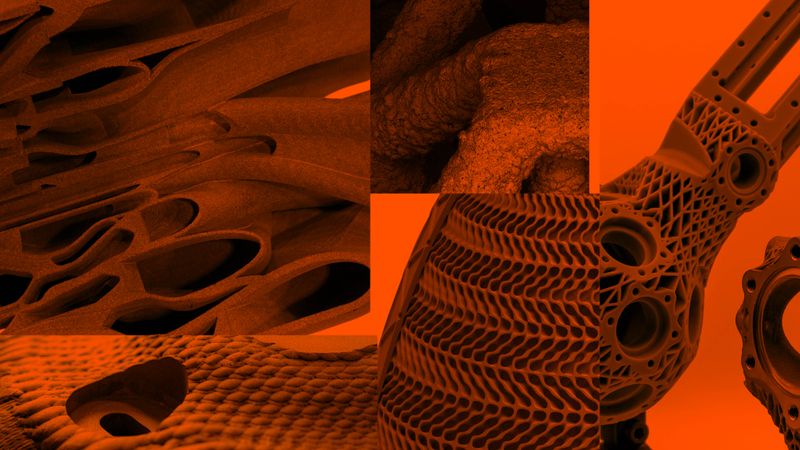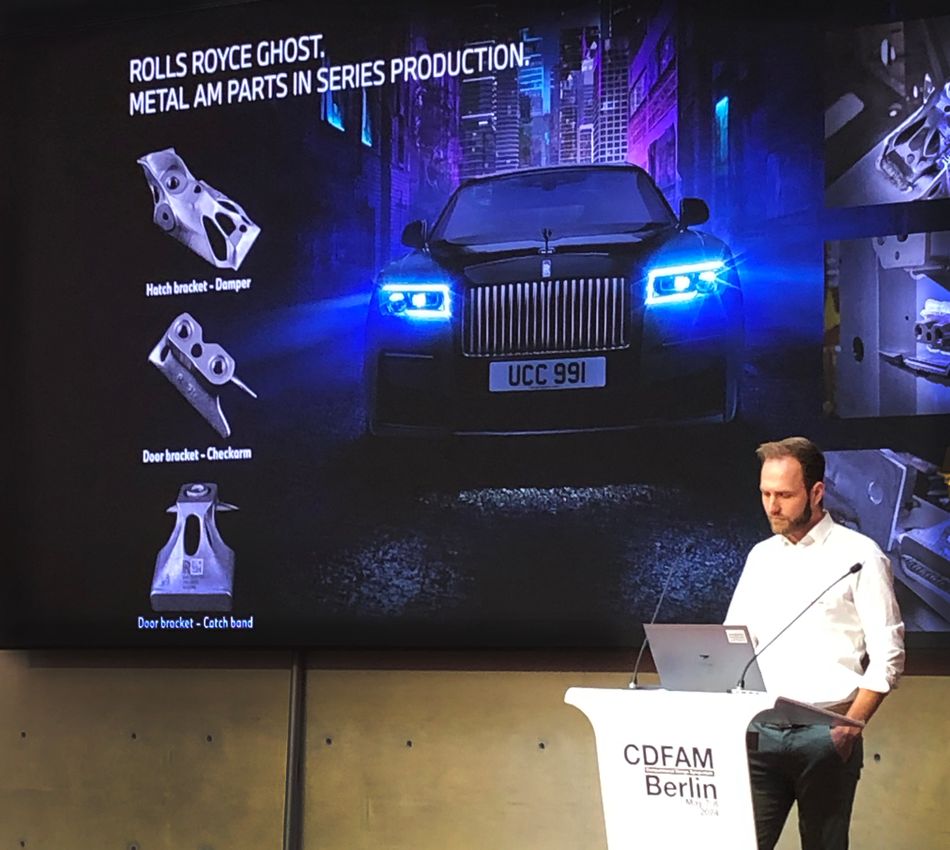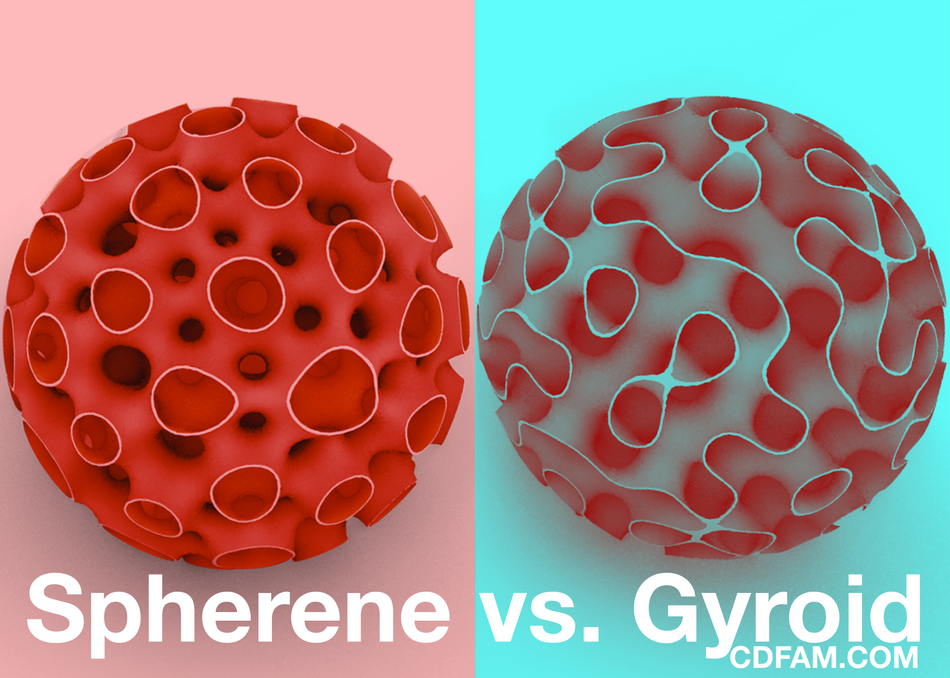Design for Additive Manufacturing at CDFAM PART II
Presentations on Design for Additive Manufacturing from the CDFAM Computational Design Symposium in Berlin, 2024

This article was first published on
cdfam.comFrom Simulation and Optimisation to Mass Production
Following on from our previous article on Design for Additive Manufacturing at CDFAM, Part 1 from NYC, Part 2 of our series turns to CDFAM Berlin from 2024, where a range of leading expert engineers, academics, and software developers shared their work around computational design, agnostic of manufacturing process, but still with a significant portion still focused on design for 3D Printing.
These DfAM presentations explored how design for additive manufacturing is being advanced through computational methodology, from multi-objective field-driven optimisation, process-aware performance and process simulation, parametric workflows for mass customisation for B2B, and consumer application, through to automation strategies.
Topics ranged from the in-depth optimization of a single high-performance part, as seen in the quantum sensing device by Metamorphic, all the way up to the development of robust, validated pipelines for mass production, as exampled by Carbon’s customized lattice workflows.
DfAM Presentations from CDFAM Berlin
C(DFAM) APPLICATIONS AND RESEARCH
Manolis Papastavrou – Metamorphic
Metamorphic presented what was arguably one of the most complete DfAM case studies ever shown at CDFAM (or anywhere) highlighting the design and fabrication of ultra-high vacuum (UHV) chambers for quantum sensing systems.
Working in collaboration with RAL Space and academic partners, the team used a computational design workflow that began with volumetric packing of laser and coil interfaces, mapping the spatial constraints of cold atom interferometry equipment. From there, they applied a combination of topology optimization and manual refinement to produce minimal-mass, high-stiffness enclosures suitable for additive manufacturing in Ti64.
The process emphasized DfAM at every stage-balancing performance, weight reduction, and geometric complexity within strict envelope constraints. The team relied on a parametric modeling approach using Rhino/Grasshopper, combined with implicit modeling techniques, to create performance-driven geometries that were not only buildable but optimized for laser powder bed fusion (LPBF).
“We had to fuse magnetics, optics, and manufacturability into one geometry—this was not possible without computational design”
Manolis Papastavrou – MetamorphicRhino/Grasshopper was used for early-stage parametric layout and implicit modeling techniques for geometric generation and refinement. These tools supported the development of compact, high-performance assemblies where magnetic shielding, thermal stability, and precise optical alignment had to coexist with LPBF process constraints.
The team maintained geometric fidelity and process compliance through iterative refinement, material-aware modeling, and frequent validation stages-all essential for meeting the strict requirements of cold atom interferometry.
The chamber designs were tailored for cold atom interferometry, integrating magnetic shielding, coil alignment, and optical path constraints within a lightweight, single-body geometry.
The exterior was reinforced with a lattice that doubled as a structural support and build aid during LPBF.
The resulting part eliminated flanges and multiple bolted sections, reducing mass and potential leakage points.
The process-from topology logic to mesh optimization, printing, post-processing, and validation-was driven by both physics and manufacturability.
This work illustrates True Computational DfAM at its most advanced: geometry generation, material performance, and manufacturing constraints solved concurrently for a high-stakes scientific application.
Johannes Pauli – BMW Group
Pauli’s keynote presentation was a hi-light of Berlin CDFAM, which unfortunately could not be recorded due to intellectual property restrictions (but you can read the interview), focused on the industrial challenges of geometry optimization for additive manufacturing in the automotive context.
At BMW, laser powder bed fusion (LPBF) is used for structural metal components, but achieving economic viability requires more than just mechanical optimization. BMW’s approach combines topology optimization to reduce material use with free-form shape optimization to eliminate overhangs and improve part nestability, resulting in reduced support structures and more efficient build layouts. This dual-stage optimization enables a higher yield of parts per build and lowers labor and material costs.

Pauli presented series production examples that would not have been economically feasible without tightly integrated manufacturability considerations.
He also discussed early investigations into Wire Arc Additive Manufacturing (WAAM) for larger components, highlighting both the promise of higher deposition rates and the current limitations in software support, which requires extensive manual intervention.

Andreas Vlahinos – Simulation Driven Design of Lattice Structures
Drawing on decades of experience, Vlahinos brought an infectious curiosity and enthusiasm as he covered challenges and techniques for analyzing and optimising lattice geometries under uncertainty, with examples including heat exchangers and aerospace components.
His presentation emphasized the impact of real-time simulation in providing immediate performance feedback, enabling engineers to quickly test and refine design decisions. This fast feedback loop builds intuition and supports exploratory workflows by embedding simulation directly within the modeling environment, helping to bridge the gap between theoretical optimization and practical manufacturability.
“Design right at the theoretical optimum, and half your parts will fail. Shift it. Design for uncertainty. That’s engineering.”
Andreas VlahinosOle Sigmund – Perfect Designs For Imperfect AM
Ole Sigmund is a world renowned professor at the Technical University of Denmark (DTU), where he has been one of the leading academic figures in the development of SIMP method (Solid Isotropic Material with Penalization) of topology optimisation.
In this area of topology optimization at CDFAM, Sigmund presented work focused on de-homogenization techniques and the use of closed-wall structures, which he positions as more robust and production-ready than traditional truss lattices.
His emphasis was on creating geometries that are both structurally efficient and manufacturable with additive processes, acknowledging the limitations of standard topology methods when applied to real-world AM constraints.
For lattice structures, he addressed the trade-offs between periodic microstructures and spatially varying features. While lattices can provide lightweight and tailored performance, Sigmund cautioned against overly complex internal geometries that may not provide sufficient benefit relative to their printability or mechanical robustness. His work underscores the need to balance AM’s promise of geometric freedom, with the harsh practical reality of the limitations of those same AM processes.
On the topic of AI in topology optimization, Sigmund continued to voice strong skepticism.
“I still stand with our original conclusions.
AI interpolates based on data or observations and is bad at extrapolating”
Professor, Department of Civil and Mechanical Engineering Solid Mechanics and the NanoPhoton – Center for Nanophotonics at the Technical University of Denmark
He pointed to the limited generalizability of machine learning models and the significant computational overhead involved in training them.
In his view, AI-based methods for topology optimization still struggle to outperform classical, gradient-based approaches, particularly in scenarios with complex boundary conditions or where physical insight is critical.
Andrew Sink & Rui Chen – Carbon
Carbon outlined high-volume AM production pipelines for customized parts with lattice structures, leveraging Carbon’s vertically integrated software and hardware ecosystem. The presenters described how Carbon’s Design Engine software enables lattice generation, geometry manipulation, slicing, labeling, and build orientation as part of an automated DAG-based (directed acyclic graph) workflow.
These workflows are stress-tested using intentionally degraded process conditions to validate robustness before mass production. The system supports performance tuning of lattice parameters using nonlinear FEA and machine learning interpolation for untested design variants. Application examples included pressure-mapped insoles, NFL helmets, dental arches, and midsoles for Adidas, where tens of thousands of unique geometries are produced monthly with consistent quality and validated manufacturability.
Chelsea Cummings – The Barnes Global Advisors
Cummings examined the evolution of additive manufacturing from novel shape production to a performance- and yield-driven design practice. She highlighted how many organizations mistakenly pursue geometric freedom without first ensuring process robustness, emphasizing that successful DfAM must begin with a clear understanding of machine behavior, process limitations, and downstream constraints.
Her presentation introduced the TBGA AM Maturity Model, a framework for evaluating an organization’s additive capability across stages of prototyping, tooling, part consolidation, and full DfAM maturity. Applications discussed included high-performance aerospace parts, field-validated brackets, and consolidated assemblies for AM-enabled production.
“We’re not trying to replicate economies of scale—we’re trying to unlock performance that scale alone can’t achieve.”
Chelsea CummingsChristian Waldvogel (Spherene) – Spherenes
Christian introduced Spherene, a surface-conformal, isotropic, support-free geometry platform with validated simulation-to-print workflows, demonstrated through ESA aerospace applications.
Waldvogel presented performance comparisons between Spherene geometries and traditional TPMS structures (and yes, they outperform Gyroids!), noting improved isotropy and predictable behavior under load.

Applications included lightweight aerospace brackets and stress-field-informed infill strategies, where support-free fabrication and mechanical consistency offered both print efficiency and structural reliability.
Bradley Rothenberg & Markus Lempke – Siemens Energy & nTop
Rothenberg discussed nTop’s implicit modeling environment for computational design, which leverages signed distance fields to generate complex geometries that are both lightweight and simulation-ready.
The software supports field-driven design, enabling engineers to modulate geometry based on stress, thermal load, or other physical fields with high precision.
Features such as real-time rendering, GPU acceleration, and differentiable geometry pipelines facilitate rapid iteration and integration with downstream simulation and manufacturing tools.
Lempke presented Siemens Energy’s application of these software tools to optimize critical components in hydrogen-powered turbines and heat exchangers.
By replacing conventional CAD geometries with field-optimized implicit models, Siemens achieved significant reductions in material usage, support structures, and build times-while maintaining or improving thermal and mechanical performance.
These workflows also incorporated voxel-based CFD and meshless simulation approaches to evaluate design alternatives earlier and with greater fidelity.
Elissa Ross – Metafold
Elissa discussed geometric infrastructure for AM, emphasizing how exact SDF modeling and meshless simulation enable the design and validation of complex structures that traditional CAD struggles to represent. Ross explained how these tools support DfAM by allowing continuous control over geometry, resolution, and structural response-key for producing printable, high-performance components.
The web-based geometry environment allows seamless integration between design, simulation, and manufacturing, facilitating scalable workflows for applications such as biofabrication scaffolds and patient-specific orthotics, where both complexity and customization are critical.
Thomas Rees – ToffeeX
Thomas presented a physics-driven generative design tool for manufacturable heat exchangers, combining multi-physics optimization with overhang and certification constraints.
Rees emphasized that ToffeeX was developed from the ground up to be AM-aware-embedding not only additive manufacturing constraints such as overhang angles and warpage limits, but also those relevant to other processes including CNC machining, stamping, and chemical etching such as overhang angles, warpage limits, and certification criteria directly into the optimization process.
The platform supports high-resolution simulation of thermal, structural, and fluid interactions while maintaining manufacturability through constraint-driven geometry generation.
By focusing on real-world design outputs rather than abstract optimization, the tool produces validated, print-ready heat exchanger geometries suited for both additive and hybrid manufacturing processes.
Alexander Pluke – Additive Flow
Additive Flow develops simulation-led design software that integrates material behavior, process parameters, and performance objectives into the early stages of product development.
The platform allows engineers to assign spatially varying manufacturing parameters such as scan speed, laser power, or layer height within a fixed geometry. These volumetric process allocations can be optimized to balance competing objectives like mechanical performance, thermal response, and production cost, without altering the part’s shape.
Pluke demonstrated how Additive Flow uses the open source 3MF volumetric extension to embed these parameter maps directly into build files, enabling interoperability with downstream tools like Autodesk Netfabb.
This capability makes it possible to simulate, optimize, and manufacture components in a tightly integrated workflow. Applications in aerospace and electronics included cost-optimized titanium brackets and thermal management components, where performance tuning was achieved entirely through process parameter variation rather than geometric redesign.
Rhushik Matroja – Cognitive Design Systems
Rhushik demonstrated CDS’ DfAM automation tools that streamline manufacturability analysis and correction within the design phase.
These include overhang detection and correction, support-aware hollowing that accounts for machine-specific build constraints, and topology post-processing that transforms raw optimization outputs into smooth, production-ready geometry.
The system supports both additive and conventional manufacturing by offering configurable modules for wall thickening, hole reshaping, draft application, and mold split generation-allowing users to adapt complex geometries to diverse production processes without manual remodeling.
Joseph Flynn – Altair
Flynn presented Altair’s approach to implicit modeling within Inspire, focusing on enabling field-driven design while retaining flexibility for user intervention. The workflow is structured to support DfAM from initial optimization through final geometry generation, offering fast, GPU-accelerated operations for creating editable lattice and surface structures. He emphasized how implicit modeling allows engineers to embed control over thickness, connectivity, and porosity as spatial fields-supporting application-specific performance tuning and print-ready geometries.
Crucially, the system also integrates point cloud and B-rep data, allowing implicit tools to interoperate with conventional CAD formats and reverse engineering inputs. This supports tasks like reconstructing topology optimization results, editing biomedical lattices for implants, or refining mesh-based geometry into manufacturable parts. Flynn highlighted orthopedic applications including acetabular cups and femoral stems, where implicit modeling is used to adjust pore structures for tissue integration while maintaining strict manufacturability constraints.
Omar Fergani – 1000Kelvin
Our friend Omar showed how AI-based thermal parameter optimization can eliminate trial-and-error in LPBF, unlocking DfAM potential through process-aware design.
Fergani explained how 1000Kelvin’s software platform uses machine learning models trained on high-resolution scan vector data to predict melt pool behavior and thermal gradients across complex builds.
These models are compressed into process control ‘recipes’ that allow designers to identify potential defects-such as overheating or lack of fusion-before printing.
Fergani described how the models are validated against optical tomography data from LPBF systems, demonstrating strong correlation between predicted and measured thermal profiles.
Andre Wilmes – Rafinex
Andre advocated for robust topology optimization with uncertainty quantification (UQ) to de-risk AM adoption, highlighting the need for design methods that account for real-world variability in loads, boundary conditions, and material properties.
Wilmes presented Rafinex’s Mobius software that use of stochastic optimization workflows that generate geometries with performance plateaus-designs that maintain acceptable performance even under uncertain conditions.
This approach aims to increase confidence in computationally optimized designs by quantifying the likelihood of failure and enabling engineers to make informed trade-offs between weight, reliability, and cost. Applications discussed included lightweight brackets for aerospace, molded plastic components with variable loading conditions, and high-precision optical mounts for satellite systems, all benefiting from UQ-enhanced design robustness.
More DfAM at CDFAM Amsterdam 2025
While this article has explored how Design for Additive Manufacturing continued as a ‘digital thread’ in Berlin, following on from the first CDFAM symposium which we featured in Design for Additive Manufacturing at CDFAM – Part 1: 2023 NYC, CDFAM Amsterdam 2025 will continue to build on these foundational ideas with a new wave of presentations (and some returning) to explore the frontier of (Computational) Design for Additive Manufacturing, including:
- Alessandro Zomparelli, AiBuild
- Aaron Porterfield, F=F
- Bradley Rothenberg, nTop
- Carbon
- Chris Robinson, Ansys
- Christian Waldvogel, Spherene
- Hamilton Forsythe, Rapid Liquid Print
- Luca Breseghello, DTU
- Mathias Fuchs, McNeel & cydric
- Or Benifla, CustoMED
- Rhushik Matroja, Cognitive Design Systems
- Thomas Rees, ToffeeX
- Tiffany Cheng, Cornell University
- Vanessa Cool, KU Leuven
- Vittoria Laghi, University of Bologna
- Wesley Essink, Altair
Topics will range from toolpath-level performance control, AI-driven manufacturability guidance, field-driven structural optimization, and scalable production of customized parts.
To learn more and take part in these conversations, register to attend CDFAM Amsterdam and connect with the engineers, researchers, and designers shaping the future of computational design and additive manufacturing.